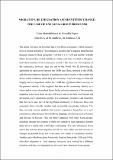Migration, re-emigration and identities’ change : The case of one Roma group from USSR
Abstract
The article will trace the historical fate of one Roma community, which currently lives in Odessa (Ukraine). The community ancestors have migrated from the then Russian Empire in China during the Civil War (1918-1922) and together with the White Russians they settled initially in Harbin, and then re-settled in Shanghai. Individual members of the community moved to the Americas. The majority of the community, however, after the end of the World War II, following the agreement on repatriation between the USSR and China, returned to the USSR, and after more than two decades of roaming the vast territories of the country the Roma settled in Odessa, where they live nowadays. Years of living in China and lengthy internal migrations within the USSR had significant effect not only on the personal identity of the migrants but also on the community identity as a whole and its vision about their future. In the collective memory of the group the migration experience from the past still exists and on its base was formed and developed a new community identity. The community members well remember that they were once part of the big Roma community of Kelderari, they even remember their erstwhile families and can identify present-day relatives. Yet, they not only present publicly but actually experience themselves as a new community, called Kitajako Rrom in Roma language, also Šanxajcurja in Romani and Šanxajci in Russian. They are firmly separated from other Roma groups, including through the creation of their own narratives and endogamic borders (they strive to marry only within their community). The case of Kitajako Rrom shows that outcome from migration and life in a new milieu can lead not only to changes on personal level, but it can create new forms of community identity. Another part of the Roma from Russia who lived in China in the 1920s and 1930s, after their migration to Latin America processes have evolved in a different direction, and they are integrated into the local Latin American Roma groups.
Citation
Marushiakova-Popova , E A & Popov , V 2019 , Migration, re-emigration and identities’ change : The case of one Roma group from USSR . in H Kyuchukov , J Balvin & L Kwadrans (eds) , Life with Music and Pictures : Eva Davidová’s Contribution to Roma Musicology and Ethnography . Roma , vol. 6 , Lincom Europa , München .
Publication
Life with Music and Pictures
Type
Book item
Description
Part of the research project RomaInterbellum. Roma Civic Emancipation between the Two World Wars which has received funding from the European Research Council (ERC) under the European Union’s Horizon 2020 research and innovation programme (Grant agreement No 694656)Collections
Items in the St Andrews Research Repository are protected by copyright, with all rights reserved, unless otherwise indicated.

